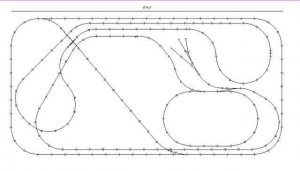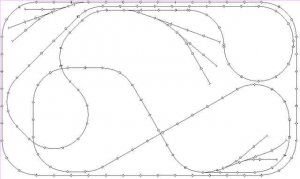Hi everyone. I'm just back from home depot, i picked up some of that foam board and i'm headed downstairs to begin setting up my first real layout. I used rts 7.0 to draw this up:

It has a couple of issues, i couldn't get the tracks in the north eastern section to line up to make 90degree crossings in the program i have no idea why, but i suspect i will not be able to get the track to line up for 90 degree crossings in real life either hahaha. The other issue is top center the 4th rail down. I couldn't get that to line up either. I used the templates for atlas code 83 tracks but the inner most 2 rings will be power loc.
I have to learn how to use elevations in the program becuase the power loc is to fly above the atlas track and i can't model it correctly in the program. I am also going to need some help wiring my bumpers as i have not a clue as how to correctly use them ops:.
ops:.
I've been rading about wiring. the only secitons that re linked are the two inner most rings as i don't know how to wire quite yet. I figrue i'll get this rolling and then play w/ wiring cross segment switches once i get my books in the mail. I boughts some small nails to stick in the little holes in the track to the foam. I have to buy some felt but i'm a little tapped so my layout is going to be pinkish for the xmas season hahaha. :thumb:
Will send pix as time goes on.
Feedback welcome looking to build a bunch o layouts ot learn.
It has a couple of issues, i couldn't get the tracks in the north eastern section to line up to make 90degree crossings in the program i have no idea why, but i suspect i will not be able to get the track to line up for 90 degree crossings in real life either hahaha. The other issue is top center the 4th rail down. I couldn't get that to line up either. I used the templates for atlas code 83 tracks but the inner most 2 rings will be power loc.
I have to learn how to use elevations in the program becuase the power loc is to fly above the atlas track and i can't model it correctly in the program. I am also going to need some help wiring my bumpers as i have not a clue as how to correctly use them
I've been rading about wiring. the only secitons that re linked are the two inner most rings as i don't know how to wire quite yet. I figrue i'll get this rolling and then play w/ wiring cross segment switches once i get my books in the mail. I boughts some small nails to stick in the little holes in the track to the foam. I have to buy some felt but i'm a little tapped so my layout is going to be pinkish for the xmas season hahaha. :thumb:
Will send pix as time goes on.
Feedback welcome looking to build a bunch o layouts ot learn.



